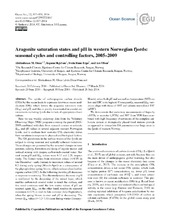| dc.contributor.author | Omar, Abdirahman | |
| dc.contributor.author | Skjelvan, Ingunn | |
| dc.contributor.author | Erga, Svein Rune | |
| dc.contributor.author | Olsen, Are | |
| dc.date.accessioned | 2017-09-21T09:31:11Z | |
| dc.date.available | 2017-09-21T09:31:11Z | |
| dc.date.issued | 2016-07-26 | |
| dc.Published | Omar A, Skjelvan IS, Erga SR, Olsen A. Aragonite saturation states and pH in western Norwegian fjords: Seasonal cycles and controlling factors, 2005-2009. Ocean Science. 2016;12(4):937-951 | eng |
| dc.identifier.issn | 1812-0792 | en_US |
| dc.identifier.issn | 1812-0784 | en_US |
| dc.identifier.uri | https://hdl.handle.net/1956/16701 | |
| dc.description.abstract | The uptake of anthropogenic carbon dioxide (CO2) by the ocean leads to a process known as ocean acidification (OA), which lowers the aragonite saturation state (ΩAr) and pH, and this is poorly documented in coastal environments including fjords due to lack of appropriate observations. Here we use weekly underway data from the Voluntary Observing Ships (VOS) program covering the period 2005–2009 combined with data from research cruises to estimate ΩAr and pH values in several adjacent western Norwegian fjords, and to evaluate how seawater CO2 chemistry drives their variations in response to physical and biological factors. The OA parameters in the surface waters of the fjords are subject to strong seasonal and spatially coherent variations. These changes are governed by the seasonal changes in temperature, salinity, formation and decay of organic matter, and vertical mixing with deeper, carbon-rich coastal water. Annual mean pH and ΩAr values were 8.13 and 2.21, respectively. The former varies from minimum values ( ≈  8.05) in late December – early January to maximum values of around 8.2 during early spring (March–April) as a consequence of the phytoplankton spring bloom, which reduces dissolved inorganic carbon (DIC). In the following months, pH decreases in response to warming. This thermodynamic decrease in pH is reinforced by the deepening of the mixed layer, which enables carbon-rich coastal water to reach the surface, and this trend continues until the low winter values of pH are reached again. ΩAr, on the other hand, reaches its seasonal maximum (> 2.5) in mid- to late summer (July–September), when the spring bloom is over and pH is decreasing. The lowest ΩAr values ( ≈  1.3–1.6) occur during winter (January–March), when both pH and sea surface temperature (SST) are low and DIC is its highest. Consequently, seasonal ΩAr variations align with those of SST and salinity normalized DIC (nDIC). We demonstrate that underway measurements of fugacity of CO2 in seawater (fCO2) and SST from VOS lines combined with high frequency observations of the complete carbonate system at strategically placed fixed stations provide an approach to interpolate OA parameters over large areas in the fjords of western Norway. | en_US |
| dc.language.iso | eng | eng |
| dc.publisher | Copernicus Publications | en_US |
| dc.rights | Attribution CC BY | eng |
| dc.rights.uri | http://creativecommons.org/licenses/by/3.0 | eng |
| dc.title | Aragonite saturation states and pH in western Norwegian fjords: Seasonal cycles and controlling factors, 2005-2009 | en_US |
| dc.type | Peer reviewed | |
| dc.type | Journal article | |
| dc.date.updated | 2017-08-30T09:17:33Z | |
| dc.description.version | publishedVersion | en_US |
| dc.rights.holder | Copyright 2016 The Author(s) | en_US |
| dc.identifier.doi | https://doi.org/10.5194/os-12-937-2016 | |
| dc.identifier.cristin | 1390010 | |
| dc.source.journal | Ocean Science | |
| dc.relation.project | Norges forskningsråd: 193825 | |

